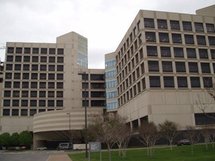
Eating excess calories may activate the cells, which leave their hiding places inside the walls of the blood vessels, the team at the University of Texas Southwestern Medical Center in Dallas reported.
These immature cells, called progenitor cells, appear to be formed at or before birth, said Dr. Jonathan Graff, who led the study published in the journal Science.
"These cells become fat cells. Being able to manipulate them or alter them offers an important potential for obesity and diabetes," Graff said in a telephone interview.
It may be possible to remove immature cells from a patient's own fat and use them to grow natural grafts, for example, for a woman after breast cancer surgery, Graff said. Cosmetic purposes might include plumping out lips or wrinkles.
"It's easily accessible," Graff said. "It's chock-a-block full of these stem cells. It's the ideal source for reconstruction."
Such cells may be useful for the field of regenerative medicine, Graff said.
Stem cell researchers hope someday to be able to remove a patient's own cells, manipulate them as needed and use them as tissue grafts or transplants to cure disease or repair injuries.
To find the cells, Graff's team genetically engineered mice so that cells that produced a large amount of a fat-regulating hormone called PPAR-gamma would glow green.
"We spent five years figuring out how to do it," Graff said.
GREEN GLOWING CELLS
They looked in fat deposits, inside the blood vessel walls, where some experts had guessed fat cells may originate. Some green-glowing cells were in there, and when taken out, they matured into fat cells.
"They're not just attached to the vessel wall, they're an integral part of it," Graff said.
The cells can react to compounds in the blood, including nutrients like glucose. Perhaps they drift out of the vessel walls when they sense enough glucose, which in turn signals that the body is taking in more calories than it needs and should store some as fat, Graff said.
Graff's team tested the cells' response to diabetes drugs known as thiazolidinediones.
Also called TZDs or glitazones, the drugs include GlaxoSmithKline Plc's Avandia, which has been linked to increased heart attack risk, and Takeda Pharmaceutical Co Ltd's pioglitazone, sold as Actos or Glustin.
The progenitor cells matured into fat cells when Graff treated them with glitazone drugs.
"One of the side-effects that people don't like is they gain 10 or 15 pounds on (these drugs)," Graff said.
But this could help explain how the drugs fight type-2 diabetes, which occurs when the body loses its ability to use insulin to convert food to fuel.
"Fat cells produce signals that control your blood sugar. We don't know what those signals are," Graff said.
"We know that skinnier fat cells send out good signals and fatter fat cells send out bad signals. TZDs alter them so that they are more insulin-sensitive." (Reporting by Maggie Fox; Editing by Julie Steenhuysen)
These immature cells, called progenitor cells, appear to be formed at or before birth, said Dr. Jonathan Graff, who led the study published in the journal Science.
"These cells become fat cells. Being able to manipulate them or alter them offers an important potential for obesity and diabetes," Graff said in a telephone interview.
It may be possible to remove immature cells from a patient's own fat and use them to grow natural grafts, for example, for a woman after breast cancer surgery, Graff said. Cosmetic purposes might include plumping out lips or wrinkles.
"It's easily accessible," Graff said. "It's chock-a-block full of these stem cells. It's the ideal source for reconstruction."
Such cells may be useful for the field of regenerative medicine, Graff said.
Stem cell researchers hope someday to be able to remove a patient's own cells, manipulate them as needed and use them as tissue grafts or transplants to cure disease or repair injuries.
To find the cells, Graff's team genetically engineered mice so that cells that produced a large amount of a fat-regulating hormone called PPAR-gamma would glow green.
"We spent five years figuring out how to do it," Graff said.
GREEN GLOWING CELLS
They looked in fat deposits, inside the blood vessel walls, where some experts had guessed fat cells may originate. Some green-glowing cells were in there, and when taken out, they matured into fat cells.
"They're not just attached to the vessel wall, they're an integral part of it," Graff said.
The cells can react to compounds in the blood, including nutrients like glucose. Perhaps they drift out of the vessel walls when they sense enough glucose, which in turn signals that the body is taking in more calories than it needs and should store some as fat, Graff said.
Graff's team tested the cells' response to diabetes drugs known as thiazolidinediones.
Also called TZDs or glitazones, the drugs include GlaxoSmithKline Plc's Avandia, which has been linked to increased heart attack risk, and Takeda Pharmaceutical Co Ltd's pioglitazone, sold as Actos or Glustin.
The progenitor cells matured into fat cells when Graff treated them with glitazone drugs.
"One of the side-effects that people don't like is they gain 10 or 15 pounds on (these drugs)," Graff said.
But this could help explain how the drugs fight type-2 diabetes, which occurs when the body loses its ability to use insulin to convert food to fuel.
"Fat cells produce signals that control your blood sugar. We don't know what those signals are," Graff said.
"We know that skinnier fat cells send out good signals and fatter fat cells send out bad signals. TZDs alter them so that they are more insulin-sensitive." (Reporting by Maggie Fox; Editing by Julie Steenhuysen)









 Home
Home Politics
Politics









